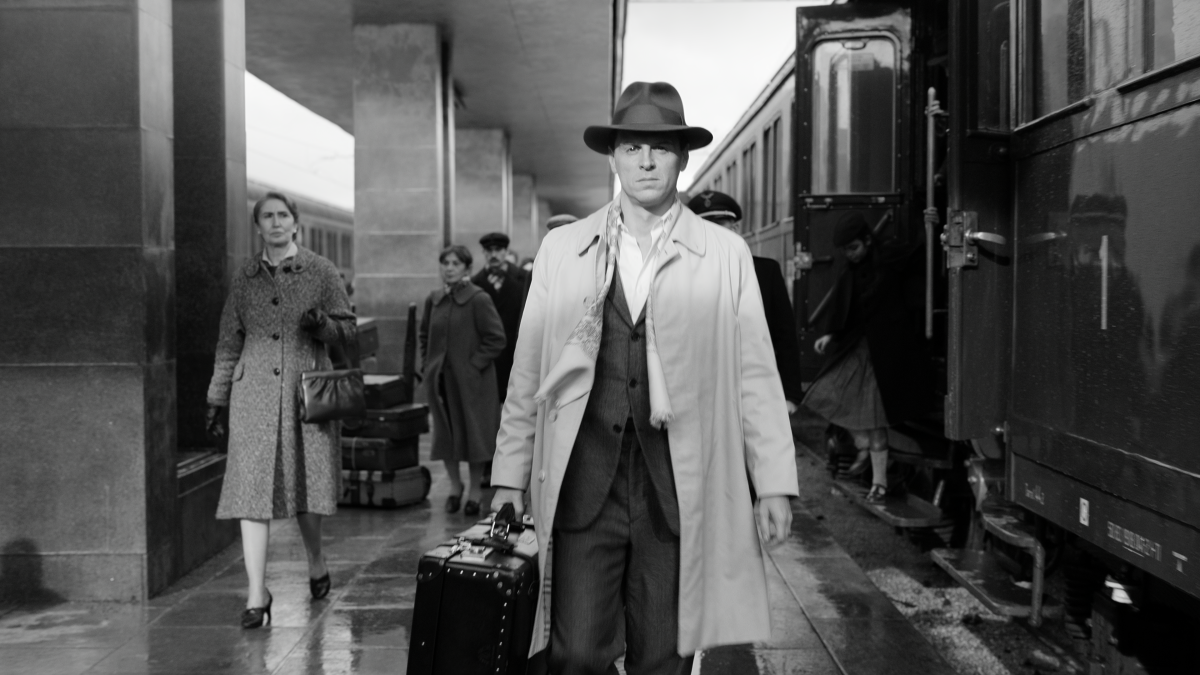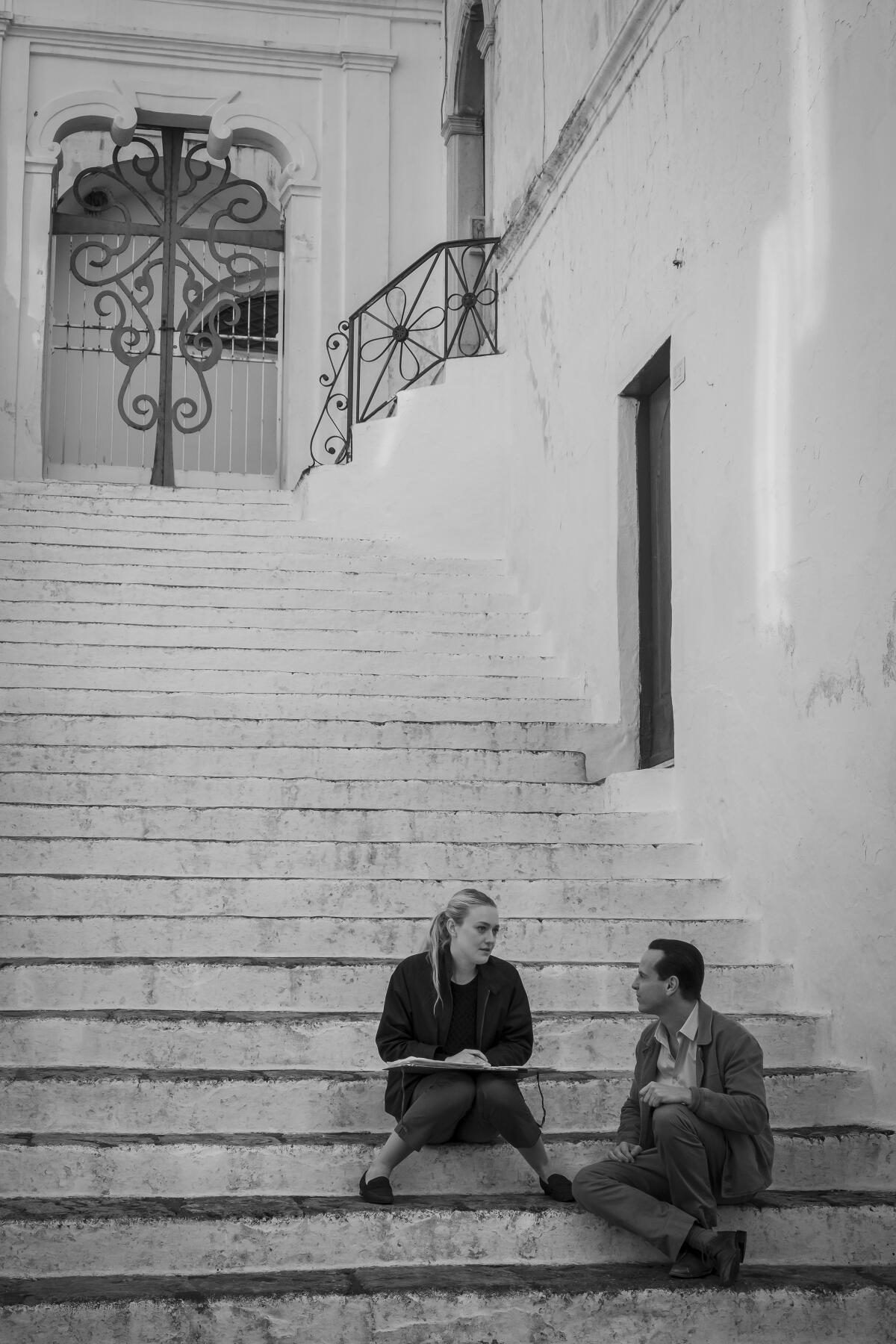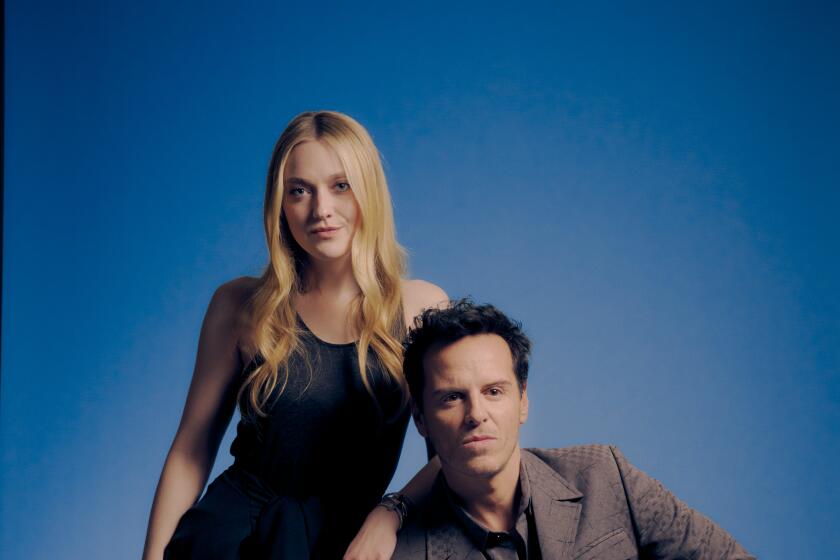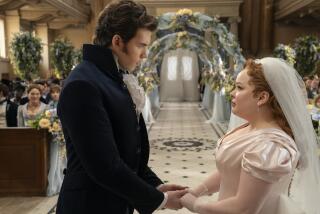Netflix’s ‘Ripley’ is a scrupulous, stylish adaptation with Andrew Scott as its star

- Share via
“Ripley,” which premieres Thursday on Netflix, is a straightforward and involving, if somewhat cold-blooded, adaptation of Patricia Highsmith’s 1955 novel “The Talented Mr. Ripley.” It alters some minor details, expands some portions, and follows the line of the book nearly to the end. (It has a slightly different idea of where to land.) In other words, it’s like every literary adaptation ever, if more scrupulous than most.
Not to give too much away to those who haven’t read the book or seen two previous adaptations — the René Clément 1960 film “Purple Noon,” which made a star of Alain Delon, or Anthony Minghella’s 1999 version with Matt Damon and Jude Law — this is the tale of a man who takes on the identity of another man, with the result that he has to spend the rest of the story devising elaborate strategies, or taking impulsive action, to protect himself.
Andrew Scott (Moriarty in “Sherlock,” the hot priest in “Fleabag”) plays Tom Ripley, a New Yorker barely getting by on small-time scams; out of nowhere, he’s offered the opportunity to travel to Italy to convince one Dickie Greenleaf (Johnny Flynn), with whom he has a tenuous connection, to return home and join his father’s shipbuilding business.

Dickie, possessor of an irrevocable trust fund, has settled in Atrani, a hillside seaside village on the Amalfi Coast, where he paints (poorly), swims, sails, sits in cafes and hangs out with Marge Sherwood (Dakota Fanning), the only other American in town, who’s writing a book about the place. Dickie has no desire to return to America, and who can blame him? After a couple of non-coincidental encounters, he invites Tom to stay at his roomy villa. Marge is doubtful. A sort of isosceles triangle is formed, which will eventually collapse.
Director-screenwriter Steven Zaillian, whose screenplays include “Moneyball,” “The Irishman,” “Awakenings” and “Schindler’s List,” has set his adaptation in 1961, six years after the book was published, and shot it in black and white. Cinematographer Robert Elswit, whose credits include “Good Night, and Good Luck,” also in black and white, and “There Will Be Blood,” which netted him an Oscar, is the series’ secret star.
The stars of Netflix’s “Ripley,” an adaptation of Patricia Highsmith’s novel, talk about why we can’t get enough of con artists, how they’ve been duped and all those stairs in the show.
Zaillian has said he was inspired by the black-and-white cover of his copy of the novel, and it is of course the default look of film noir. But I would note, too, that 1961 falls between Fellini’s “La Dolce Vita” — the title of the series’ fourth episode, not incidentally — and “8 1/2,” and at the midpoint of Michelangelo Antonioni’s great “trilogy” of “L’Aventurra,” “La Notte” and “L’Eclisse,” their last films before turning to color, masterpieces of tonal control and composition. There’s barely a frame of “Ripley” that isn’t thoroughly considered; it’s conspicuously stylish, but never mannered.
The action travels from Naples to Rome to Venice (and up and down many stairs — it’s a motif). We’ve grown so accustomed to seeing the world in color, through movies and travel shows and such, that much of the romance of those pictures has been washed away; the monochrome images paradoxically refresh these scenes, sharpen edges, invite your examination. The camera — like Tom, by extension — takes pleasure in the texture of a pitted wall, in the smooth marble of Baroque sculptures, and looks lovingly on all manner of objects, appropriate to a story partially about the power of things to define taste, furnish a life, create a self. (They can be dangerous too: a glass ashtray purchased in one act will crack a skull in another.)
Tom, whose sense of self is variable, even if his sense of entitlement is not, wants what Dickie has, which in essence is to be Dickie. The Italian instruction record that plays in the background as Tom ambles about his host’s art-filled villa mirrors his ambition: “How much money do you need?” “It’s not enough.” “What’s the matter with you?” “What happened?” “Who said so?” “Who is he?” “Who knows?” “Whose is this?” “It’s yours.” … “It’s mine.”

At 47, Scott is nearly twice the age of Highsmith’s Ripley, which puts a different spin on the character. (This might be convenient, however, if Netflix continues the series, as the stripped down title suggests it might; the fifth and final Ripley book, “Ripley Under Water,” was published 36 years after the first.) His vaguely lined mien suggests premature strain, which feels at odds with a character we’re to take as an expert dissembler, not to say a sociopath.
Still, it’s not easy to portray a person whose constructed public self is at odds with the private, and who can’t always tell the difference between the two. Highsmith’s novel is written from Tom’s complicated, contradictory point of view, which allows the reader to identify with him, even as his behavior grows increasingly unacceptable; seen from the outside, he feels more like a case study than a protagonist. The effortful, pasted-on smile Tom wears in the early episodes comes off as creepy and pitiful; and though Tom is creepy and pitiful, it’s hard to credit him charming his way into Dickie’s company, let alone establishing the perceived friendship upon whose fortunes the plot will psychologically depend. Later, when he has achieved his goal of becoming someone else, he does seem to relax, to become better company.
Zaillian’s most significant addition to the text centers around the paintings of Caravaggio, which Dickie introduces to Tom, and Tom continues to visit on his own. This might be a subtle linking of the painter’s bisexuality, which is not discussed, to Tom’s confused sexuality, which is barely noted — “Ripley” is the antitheses of homo-eroticism — but also his violent life. As Tom views Caravaggio’s “David With the Head of Goliath” at the Galleria Borghese in Rome, a docent explains how the painter has linked “the killer and his victim by portraying David as compassionate, even loving” and, most applicable to Tom’s situation, using himself as the model for both. It might also have something to do with Caravaggio’s use of darkness and light, as a comment on Tom’s character and aspirations. Or it could just be that Zaillian wanted to visit those paintings himself, and to photograph the extraordinary settings where they’re hung — it’s a plus, anyway.
Most felicitously, Zaillian has expanded the role of the police inspector (sad-eyed Maurizio Lombardi) who comes to investigate some unexplained absences and brings a weary, workaday warmth into the show. For a time, we are in the familiar moral universe of a detective story, which might make Tom nervous but provides the viewer some relief. For that matter, the clerks and waiters, maids and landlady and other regular Italians who fill out the action provide a counterweight to our screwy American hero and tether “Ripley” to the ordinary, less disturbing world.
The landlady has a cat, too, that gets a lot of screen time, and is quite good.
More to Read
The complete guide to home viewing
Get Screen Gab for everything about the TV shows and streaming movies everyone’s talking about.
You may occasionally receive promotional content from the Los Angeles Times.








